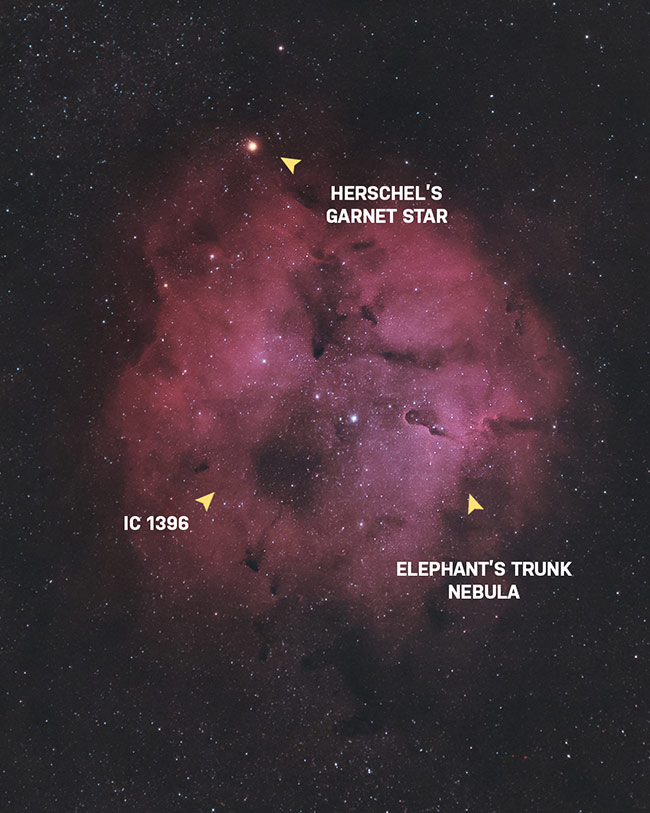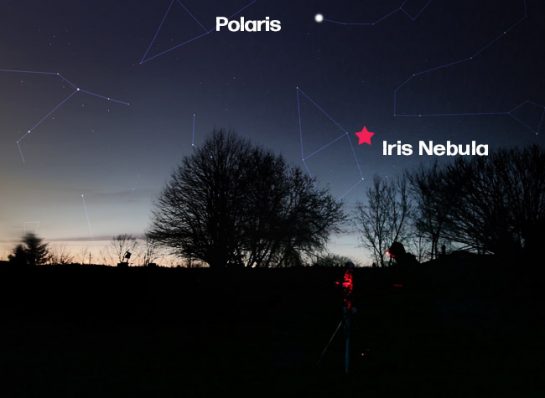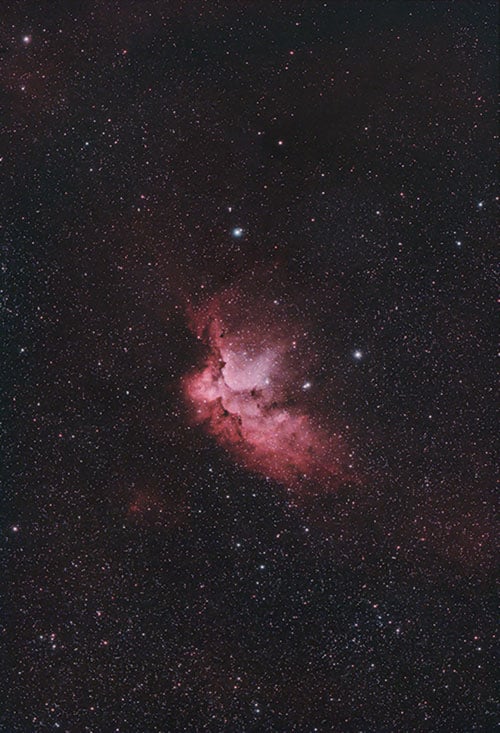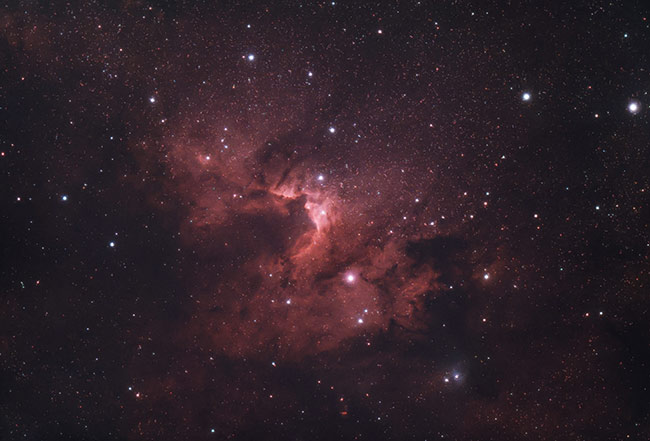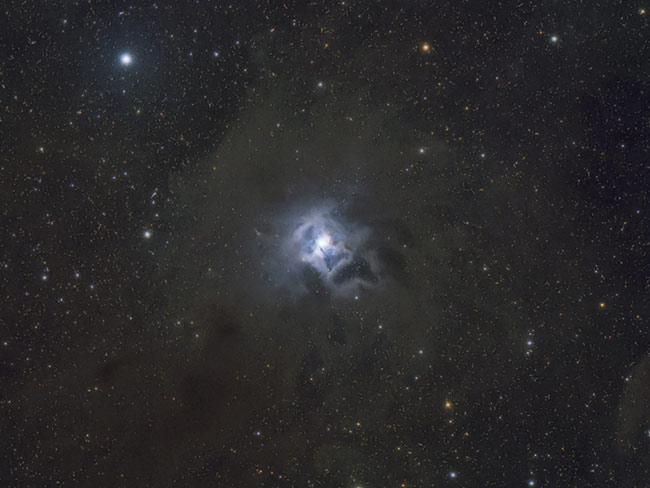The Cepheus Constellation
The constellation Cepheus is a northern hemispheric constellation that is visible all year round. This constellation can appear faint, but it is easily located in the north in August and September evenings. It has a distinctive shape that resembles a house. Cepheus is visible to the upper right of Polaris, the North Star.
This constellation inherited its name after the mythical king of Ethiopia. Cepheus is the 27th largest constellation in the night sky, occupying an area of 588 square degrees. Cepheus was one of the 48 constellations listed by the second-century astronomer Ptolemy. It is one of the 88 constellations we still see today.
Cepheus belongs to the Perseus family of constellations; along with Andromeda, Auriga, Cassiopeia, Cetus, Lacerta, Pegasus, Perseus, and Triangulum.
Interesting Facts about Cepheus
- Cepheus is a constellation in the northern sky
- Cepheus was a king of Aethiopia in Greek mythology.
- Cepheus has one star with known planets.
- The brightest star in the constellation is Alderamin, Alpha Cephei.
- There are no meteor showers associated with Cepheus.
Location
You can locate Cepheus in the fourth quadrant of the northern hemisphere (NQ4). It is positioned between the latitudes +90° and -10°. The neighboring constellations are Camelopardalis, Cassiopeia, Cygnus, Draco, Lacerta, and Ursa Minor.
This constellation rotates around Polaris in a counter-clockwise direction throughout the night. It swings high over Polaris after midnight and then sweeps to the left side of Polaris around dawn.
Cepheus’ Prominent Stars
The constellation is home to Herschel’s Garnet Star, also known as Mu Cephei. This star is a red supergiant or also referred to as a hypergiant. This star, Mu Cephei, is located slightly below the constellation’s outline and resembles the bottom of the house, roughly in the middle.
This star is one of the largest known stars in the Milky Way. It has a diameter of 1.753 billion km. For a better understanding of its massive size, if we place this Garnet Star in our sun’s position, it would reach somewhere between the orbit of Jupiter and Saturn.
The Garnet Star, Mu Cephei, appears garnet red and is located at the edge of the IC 1396 nebula. (Wikipedia). Mu Cephei is visually 100,000 times brighter than our Sun, with a magnitude of −7.6.
Herschel’s Garnet Star and IC 1396 in Cepheus.
Within the constellation’s outline, Cepheus’s brightest star is Alpha Cephei. This star is located at the bottom right corner of the house. It has a magnitude of 2.5. This star rotates at a very high speed, at least 246 km/s, and completes one revolution in approximately 12 hours. It is a white class A star, currently evolving into a subgiant star.
Alpha Cephei is approximately 49 light-years distant from our solar system and can be seen by the naked eye. Alpha Cephei’s traditional name, Alderamin, is derived from the Arabic phrase að-ðirā‘ al-yamīn, translating to “the right arm.”
When observed from Europe, northern Asia, Canada, and most North American cities, Alderamin will never set below the horizon.
Delta Cephei is the prototype of an important class of star known as a Cepheid variable. It is a yellow-hued supergiant star 980 light-years from Earth; The Cepheids are a class of pulsating variable stars; Delta Cephei has a minimum size of 40 solar diameters and a maximum size of 46 solar diameters. It is also a double star; the yellow star also has a wide-set blue-hued companion of magnitude 6.3.
Gamma Cephei is a binary star in Cepheus. Gamma Cephei is classified as an orange subgiant (spectral type K1III-IV) and is believed to be 6.6 billion years old. It can be seen by the naked eye.
The star’s traditional names are Alrai, Er Rai and Errai, derived from the Arabic ar-rā‘ī, which means “the shepherd.”
Zeta Cephei is an orange subgiant belonging to the spectral type K1 IV. It has an apparent magnitude of 3.39 and is approximately 730 light-years distant. The star marks the left shoulder of Cepheus.
Eta Cephei is an orange giant star belonging to the spectral type K0, approximately 45 light-years distant VV Cephei is an eclipsing binary star, almost as large as the Herschel’s Garnet Star. It consists of a red hypergiant and a blue companion star.
VV Cephei A, is the third-largest star known. It has a solar radius between 1,600 and 1,900.
V381 Cephei is a red supergiant with an apparent magnitude of 5.66, approximately 3,663 light-years distant. It is a pulsating variable star.
Kruger 60 is a binary star composed of two red dwarfs that orbit each other with a period of 44.6 years. The star system is only 13.15 light-years (4.03 parsecs) distant.
The location of the Iris Nebula in Cepheus from my backyard.
Deep Space Objects
Cepheus has the hyperluminous quasar S5 0014+81, which hosts an ultra-massive black hole in its core. It is reported at 40 billion solar masses, about 10,000 times more massive than the central black hole of the Milky Way.
This puts this black hole among one of the most massive black holes currently known.
The Fireworks Galaxy is an intermediate spiral galaxy in Cepheus. It is approximately 22 million light-years distant. It lies on the border between Cepheus and Cygnus. The galaxy was discovered by William Herschel in September 1798.
NGC 7380 is an open star cluster also known as the Wizard Nebula. It was discovered by Caroline Herschel in 1787. The cluster is embedded in a nebula making it 110 light-years in size.
NGC 7380 – The Wizard Nebula.
The cluster is located within the Milky Way Galaxy and approximately 7,000 light-years distant from us. The stars in the Wizard Nebula are less than five million years old, making it a young open cluster.
Caldwell 9 – The Cave Nebula.
NGC 7538 is an emission or reflection nebula. The nebula contains the biggest protostar discovered to date. The protostar, located in the Perseus Spiral Arm of the Milky Way Galaxy, is 300 times the size of our solar system.
NGC 188 is an open star cluster, approximately 5,400 light-years distant. It is one of the oldest known open clusters. It lies about five degrees away from the North Celestial Pole. It was discovered by the English astronomer Sir John Frederick William Herschel in 1825.
The Iris Nebula (NGC 7023) is a reflection nebula. It is approximately 1,300 light-years distant. The object is really a star cluster embedded inside a nebula.
NGC 7023 – The Iris Nebula.
The Ghost Nebula resides near the Iris Nebula, another reflection nebula with plenty of reflected interstellar dust.
NGC 7129 is an open cluster star-forming region located in a reflection nebula that has the shape of a rosebud. The cluster contains more than 130 young stars, believed to be less than a million years old.
NGC 7142 is another open cluster in Cepheus. It is approximately 6,200 light-years distant. The cluster lies in the vicinity of the nebula NGC 7129 and is believed to be obscured by an interstellar cloud.
“A Rotten Fish, a Dark Shark and Wolf’s Cave”. Photo by Jan Schubert.
Origins and Mythology
The Constellation Cepheus is named after the mythical king of Aethiopia. Cepheus was the husband of Cassiopeia and the father of Andromeda. It is said that Zeus placed him among the stars after his death because he was descended from the nymph Io, who was one of Zeus’ favorites.
Cepheus is usually depicted as a robed king with a crown of stars. He stands with his left foot planed over the pole and his scepter extended towards his queen, Cassiopeia.
Cepheus. “The King with a Crown of Stars”. (Wikipedia)
Cassiopeia was a very vain woman. She boasted that she was more beautiful than the Nereids, sea nymphs. This angered the sea god Poseidon, who then sent a sea monster upon them. This sea monster is represented by the constellation Cetus.
Cepheus turned to an oracle for advice on how to prevent this disaster. The oracle told Cepheus that to appease Poseidon he would have to sacrifice his daughter Andromeda to the sea monster.
In Cepheus’ desperation, he chained his daughter to a rock for the sea monster Cetus to find. Luckily, Perseus found the princess first. He heroically killed the monster to rescue her. Perseus later got the blessing from Cepheus to marry Andromeda.
Perseus and Andromeda were celebrating their wedding when Phineus, Cepheus’ brother, turned up. Andromeda had previously been promised to marry Phineus. Phineus and his followers asked that Andromeda be turned over to them, but Cepheus refused them and there was a fight.
Perseus tried to fight off his opponents, but he was sorely outnumbered. He was forced to use the head of Medusa to turn his enemies into stone. Unfortunately, the king and queen did not look away from the Gorgon’s head in time and were also turned to stone.


